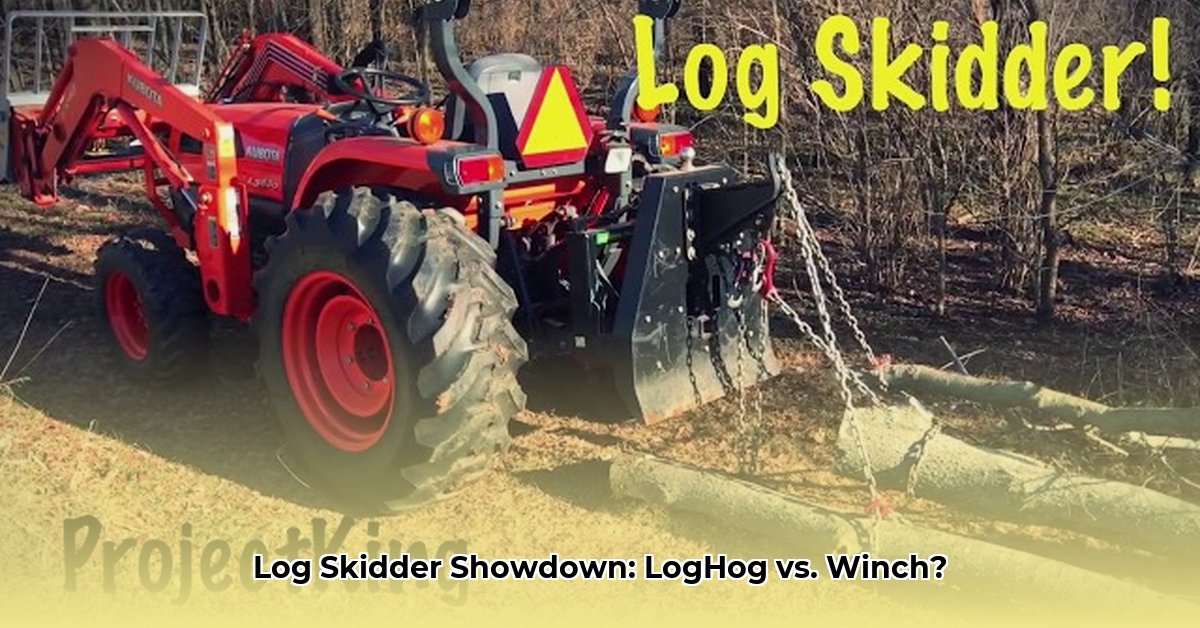
Choosing the right log skidder significantly impacts the efficiency and sustainability of your forestry operation. This guide compares two popular options: LogHog systems and skidding winches, providing a detailed analysis to help you make an informed decision. We'll cover operational details, cost considerations, maintenance needs, and safety protocols. For more on tractor winches, visit this helpful resource.
Section 1: Introduction to Log Skidding in Sustainable Forestry
Efficient and sustainable log removal is crucial for responsible forestry. Log skidders play a vital role in this process, minimizing soil disturbance and reducing environmental impact compared to less controlled methods. Selecting the appropriate skidder depends heavily on factors such as terrain, budget, and operational scale.
Section 2: The LogHog System
The LogHog system is a relatively simple, gravity-assisted log-skidding attachment for tractors. It utilizes a lever and cable system to pull logs, offering a user-friendly approach to log extraction. (See Figure 1 – Illustration of LogHog System).
Advantages:
- Simplicity & Ease of Use: The straightforward design makes the LogHog easy to learn and operate, even for beginners.
- Low Maintenance: Fewer moving parts translate to lower maintenance costs and less downtime.
- Cost-Effectiveness: The initial purchase price is significantly lower than most skidding winch systems.
- Reduced Soil Compaction: Its design generally minimizes soil disturbance compared to winch systems.
Disadvantages:
- Limited Capacity: The LogHog is best suited for smaller logs and less challenging terrain. Larger logs or significant inclines will significantly limit its effectiveness.
- Manual Operation: The system requires more manual labor compared to the automated capabilities of winches.
- Terrain Limitations: Performance is significantly reduced in wet, muddy, or steeply sloped conditions.
Section 3: Skidding Winch Systems
Skidding winches offer a more powerful and versatile solution for log extraction. These systems utilize a cable and drum mechanism powered either hydraulically or by the tractor's PTO (Power Take-Off). They are significantly more capable of handling larger logs and more challenging terrain. (See Figure 2 – Illustration of Skidding Winch System).
Advantages:
- High Capacity & Pulling Power: Skidding winches can easily handle larger logs and negotiate significantly more challenging terrain.
- Versatility: Beyond log skidding, they can be used for other tasks such as vehicle recovery or even assistance with tree felling. Many modern models feature remote control operation enhancing safety.
- Remote Operation (often): Most winch systems offer optional remote control capabilities, improving both safety and operational efficiency.
Disadvantages:
- High Initial Cost: Skidding winches represent a significant upfront investment compared to LogHog systems.
- Increased Complexity & Maintenance: The increased complexity results in higher maintenance needs and potentially higher repair costs.
- Steeper Learning Curve: These systems require greater operator skill and training for proficiency and safe operation.
Section 4: Head-to-Head Comparison: LogHog vs. Skidding Winch
| Feature | LogHog | Skidding Winch |
|---|---|---|
| Initial Cost | Low | High |
| Log Handling Capacity | Low | High |
| Maintenance | Low | Moderate to High |
| Terrain Suitability | Limited (flat, dry conditions) | Versatile (handles steep and wet terrain) |
| Ease of Use | High | Moderate (dependent on system complexity) |
| Environmental Impact | Generally minimal | Potentially higher, dependent on usage |
Section 5: Choosing the Right System: A Decision-Making Guide
The optimal log skidding system depends on your specific needs and operational context. Consider the following factors:
- Budget: LogHog systems are significantly more budget-friendly. Winches represent a far greater financial commitment.
- Terrain: Winches are better suited for challenging terrain, while LogHog systems perform best in flat, dry conditions.
- Scale of Operation: Small-scale operations might find a LogHog sufficient. Large-scale operations necessitate the power and capability of a winch.
- Log Size: The size of logs you typically handle significantly influences the required capacity of your system.
- Operator Experience: LogHog systems are significantly easier to learn and operate.
Decision Flowchart:
(See Figure 3 – Decision Flowchart illustrating selection process based on budget, terrain, and scale of operation)
Section 6: Safety and Regulatory Considerations
Safety is paramount in forestry operations. Always adhere to all applicable local and national regulations, and consult the manufacturer's guidelines for specific safety procedures. Regular equipment inspections, appropriate personal protective equipment (PPE), and thorough operator training are essential for minimizing risk. Ignoring safety measures can lead to serious injury or even fatality.
Section 7: Maintenance and Troubleshooting
Regular maintenance is crucial for extending the lifespan of your equipment. This includes regular inspection of cables, hydraulic lines (for winches), and all moving parts. Preventative maintenance is far more cost-effective than emergency repairs. Consult your owner's manual for specific maintenance schedules and troubleshooting guidance. For complex issues, contacting a qualified technician is recommended.
Key Takeaways:
- LogHog systems are simple, affordable, and easy to use, but are limited in capacity and terrain suitability.
- Skidding winches offer greater power, versatility, and capacity but require a higher initial investment and more complex maintenance.
- The ideal choice depends on your operational scale, budget, terrain, and experience level.
- Prioritizing safety and regulatory compliance is crucial for responsible and sustainable forestry.